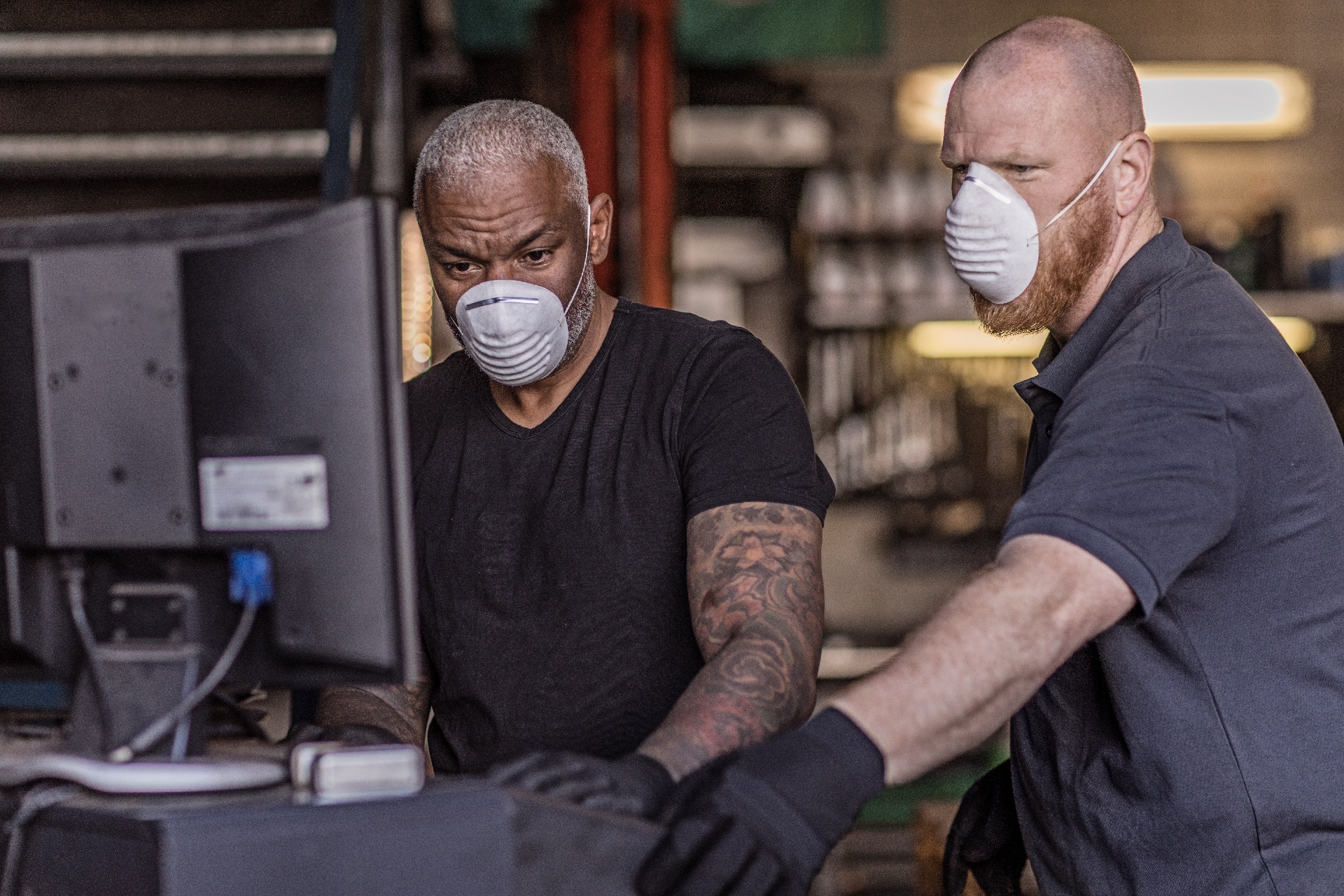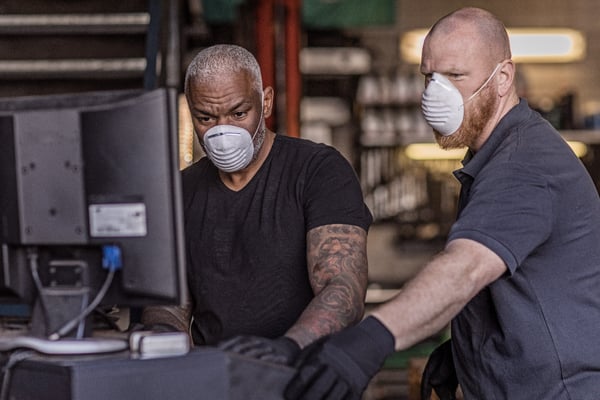The essential workforce has been challenged more in 2020 than perhaps at any other point in recent history. Stories of selflessness and bravery and dauntless spirits fill our news feeds and the media. As a company that has its own essential employees, we know the sacrifices made and the support these team members deserve as the 'new normal' continues to set in. In the instance of nutrition and hydration, we can help support these people even more throughout their workdays.
Essential Workforce

The national rate of essential workers across each state is 45.2%. That's a lot of employees going to and from work and adhering to new mandates and precautions relating to the pandemic. And, according to the DHS Cybersecurity & Infrastructure Security Agency (CISA), there are 14 employment categories that the agency identifies as Essential Critical Infrastructure Workers. These include:
- Health care and public health workers
- Law enforcement, public safety, and first responders
- Food and agriculture workers
- Energy employees
- Waste and wastewater
- Transportation and logistics
- Public works
- Communications and information technology
- Other community-based government operations and essential functions
- Critical manufacturing
- Hazardous materials
- Financial services
- Chemical workers
- Defense industrial base
Why Hydration is Important to Every Employee
Today we’re going to talk about the importance of hydration. No, not importance. That’s not a strong enough word. Let’s talk about the NECESSITY of hydration, and kick things off with some interesting facts and figures:
75% of your muscle mass is water.
85% of your blood is water.
80% of your skin’s mass is water.
90% of your lung mass is water.
75% of your brain is water.
24% of bone mass is water.
We are fluid creatures — to say the least! And every moment of every day we need to constantly replenish the precious H2O that makes us tick. This is especially vital when physical activity, like that which takes place on your company’s production floor, is in full swing as workers perspire and burn through their bodies’ water reserves.
Some More Percentages
• To maintain peak levels of productivity, the human body needs full hydration. A mere 1% drop in hydration can lead to a 12% drop in productivity. A 3-4% drop in hydration can result in a productivity decline of 25% to 50%. That’s huge. And it directly affects your business’s bottom-line profitability.
• By the time an employee experiences the sensation of being “thirsty,” they may already be 2-3% dehydrated. As little as 3% dehydration can slow human reaction times to the same extent as a .08 Blood Alcohol Content (BAC). A driver is five times more likely to cause a car accident at .08 BAC. So, by the same math, a dehydrated worker is far more likely to have a work-related accident than his/her hydrated coworkers.
• A worker can lose 5-10% of the body’s water content during vigorous, physical labor.
• 75% of Americans suffer chronic dehydration every day. We simply do not drink enough water, and this seriously affects brain functions like short-term memory, focus, and visual motor tracking.
• A general recommendation is for people to drink between 8-10 glasses of water a day to remain hydrated. Naturally, the actual amount required can depend on a person’s body size, weight, overall health, the type of work they do, etc.
• Even though employers are required by law to provide employees with drinking water, a large percentage of employees don’t know about the importance of staying well-hydrated. An involved company with good leadership and good intentions can help that pattern.
LEARN HOW TO REVAMP YOUR WORKPLACE WITH OUR FREE CHECKLIST
How to Increase Employee Productivity With Hydration
First, make hydration your #1 employee priority. Workers with healthy, satisfied thirsts are more motivated, focused, productive, and safe. They’re also happier—proven fact. These are all good things, which is why every company should make hydration the cornerstone of its workplace wellness strategy.
It Begins with Education
Surprisingly, most Americans don’t know just how critical hydration is in their lives and work. Tell them. Use this blog and all those facts at the beginning to get the ball rolling. Have a company-wide meeting to educate and motivate people on the subject.
• Consider giving everyone a high-quality water bottle with the company logo on it as a wellness token that’ll be used and appreciated.
• Develop a written policy and set hydration goals.
• Reward people’s required water intake with healthy rewards.
• Offer complimentary water so employees always have access to unlimited, cold water supplies.
• Encourage employees to consume water while on break—and enforce break times to ensure that they take the time to get the fluids they need.
• Train managers and supervisors to recognize the signs of dehydration and address employee needs when they arise.
• Be aware of environmental factors that can make dehydration more likely, like high temperature areas, extreme dust, strenuous work activity, etc.
• Promote drinking at least two liters of water daily, broken up into eight equal portions per day.
• Integrate other healthy hydrating beverages into your company’s offerings, including fruit juices, Gatorade, and sparkling waters.
• Share the importance of limiting coffee to four cups a day since caffeine is a leading cause of dehydration.
The Ideal Hydration Offerings to Support Social Distancing
Of course, water is the primary source of hydration to make readily accessible to your staff. The question is, what is the delivery method that promotes the most usage?
Water Fountains
Water fountains are affordable and turn on with the rest of your operation’s plumbing. However, many people shy away from using public water fountains during the pandemic for good cause. The handles, spigots, and basins on water fountains can pose heightened health risks for your employees. Consider closing water fountains or creating signage with instructions on best practices for filling personal water bottles instead of drinking directly from the spigot.
COVID-19 aside, this can lead to more sick days, since these moist areas are breeding grounds for bacteria like E-coli, legionella, and coliform. Some surveys conducted prior to 2020 indicated that 76% of Americans will NOT drink from a public fountain. How can you expect your employees to practice proper hydration if most of them avoid fountains, especially now?
Jug Dispensers
These are a popular solution, but they have drawbacks, too—like hidden costs, storage hassles, maintenance, and employees’ aversions to public dispensers. Often, jug-dispensed water offers no difference than tap water, yet comes at an additional cost.
Bottled Water
Partnering with a beverage distributor like Bernick’s provides the highest-quality drinking water in personal-use bottles. Brands like Aquafina and others ensure that each bottle contains 100% purified, filtered water. Bottled water eliminates the potential for public-use contamination and promotes workplace safety. And the best part is that when an employee cracks the lid on a bottle of water, they are likely to drink the entire bottle to avoid waste—since a bottle of water has a high perceived value.
Other Hydration Options
Bernick’s can also work with businesses to bundle water with other sources of effective hydration, including fruit juices, flavored sparkling water, and sports drinks like Gatorade that are fortified with electrolytes to help replace what workers lose during periods of physical labor. All drinks can be made accessible through coolers, low- or zero-cost vending machines, company refrigerators in the break room, or even Bernick’s micro markets.
Providing branded bottled water and other beverages sends a message to employees that the business owners, managers, and supervisors truly care about their health and safety. It should never be viewed as an expense, but rather as an investment that pays dividends down the road in increased productivity, heightened focus, improved problem-solving abilities, reduced sick time, and happier, more collaborative employees.
As the emphasis on health continues this year and proper hydration becomes even more essential, take action to keep your staff healthy, and get as much productivity as possible from everyone through adjustments made in workplace practices. Support their health and provide them with the best possible options for hydration and overall health and wellness.
Author's Note: This post was originally published in August 2019 and has been updated to reflect the most recent trends and data.



